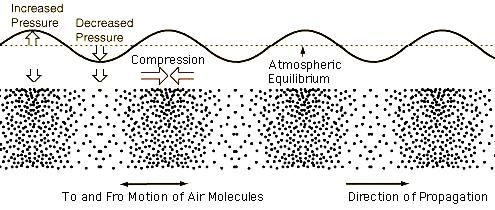The orthodox view of a wave and wave motion is centered around a sine wave or similar configuration. In general this wave model is a measurement of a quantity and/or polarity of energy, sound pressure or sound power (amplitude), viewed over time, as the wave passes a sensing device such as a microphone. Empirical measurements have been made of pressure or power fluctuations over time and a plotting of these measurements creates the typical sine wave form. There doesn't seem to be much said about the nature of that wave itself or the Positive or negative phase. Of which parameters, we (SVP) are coming to see numerous attributes and dynamics. (See Eighteen Attributes or Dimensions) Orthodoxy does recognize that during the Positive or compression phase the media substance does compress or bunch up then in the negative phase the media disperses or rarefies. Orthodoxy erroneously assumes this periodic gathering together and dispersing of the media substance is due to physical forcing of the particles together or them somehow pulling away from each other during the rarefaction phase. In Figure 8.2 - Compression Wave Phase Illustration are shown both models of sine wave along side compression/rarefaction illustrations. It turns out there are many things happening during the compression and rarefaction phases. See Syntropy and Entropy as also 9.30 - Eighteen Attributes of a Wave, 12.11 - Eighteen Attributes or Dimensions and Eighteen Attributes or Dimensions.

Figure 8.2 - Oscillation versus Vibration - Compression Wave Phase Illustration
The speed with which light presumably travels is 186,400 miles per second. The distance between stars is so great that the speed of light is computed as light years, for the distance computed by lesser units of time would yield figures so great that they would be meaningless.
Light only seems to travel. It is but one more of the countless illusions caused by wave motion. Waves of the ocean seem to traverse the ocean but they only appear to do so, for waves are pistons in the universal engines, and pistons operate up and down. Wave pistons of light, or of the ocean, operate radially and spirally inward and outward, toward and away from gravity.
Waves of light do not travel. They reproduce each other from wave field to wave field of space. The planes of zero curvature which bound all wave fields act as mirrors to reflect light from one field into another. This sets up an appearance of light as traveling, which is pure illusion.
The sunlight we feel upon our bodies is not actual light from the sun. What actually is happening is that the sun is reproducing its own condition on the earth by extending the reproductions out through cold space into ever enlarging wave fields until those reproductions begin to converge again toward our center of gravity into ever smaller wave fields. The heat we feel and the light we see are dependent entirely upon the ability of the wave fields to reproduce the light and heat, and that ability is conditioned upon the amount of moisture in the atmosphere.
If there were no moisture in the atmosphere, our bodies would carbonize from the heat thus reproduced. One cannot consistently think of that heat as direct rays of the sun, for that same sunlight was intensely cold during its reproduced journey through the immensely expanded wave fields of space between the sun and earth.
The light and heat which appear to come from the star or sun have never left the star or sun.
That which man sees as light and feels as heat are the reproduced counterparts of the light and heat which are its cause. The rate of vibration in a wave field depends upon its volume. Vibration in a wave field means the pulse of interchange between its compressed core and the space surrounding that core. A slow vibration in a large wave field would cool one's body, or even freeze it, while fast pulsing interchange in extremely small wave fields could burn one's body.
A lens which multiplies light and heat toward a focal point which sets paper on fire merely compresses larger wave fields into smaller ones. The rate of vibration increases for the same reason that the planets nearest the sun move much faster in their small orbits than those which are far away from the sun. Kepler 's law covering the speeds of planets will apply to rates of vibration in wave fields as appropriately as with the movements in the solar system. [Walter Russell, The Secret of Light, pages 169-171]
See Also
8.3 - Conventional View of Wave Motion
8.4 - Wave types and metaphors
9.30 - Eighteen Attributes of a Wave
12.11 - Eighteen Attributes or Dimensions
Compression Wave
Compression Wave Velocity
Differentiation
Eighteen Attributes or Dimensions
Entropy
Figure 8.3 - Coiled Spring showing Longitudinal Wave
Figure 9.11 - Compression Wave with expanded and contracted Orbits
Longitudinal
Longitudinal Waves in Vacuum
Rayleigh Wave
Refraction
Sound
Sound Absorption Coefficient
Sound Power
Sound Pressure
Syntropy
Transverse Wave
Wave
Wave Field
What Vibration Is
